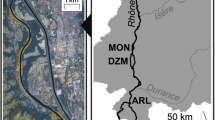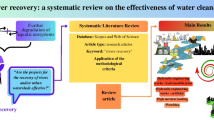Abstract
In this study, we assumed that river rehabilitation refers to a set of ecological and managing actions aimed to recuperate the natural conditions of a river system to sustain biodiversity, permit recreational uses, manage floods, and conciliate the landscape progress. Through this study, we intended to understand the hydrological- and water quality–related variables of three urbanized catchment areas, as well as evaluate the achievement of in-stream biophilic structures previously designed and installed to possibly mitigate the degradation status of such river stretches. In three urbanized rivers located in Sorocaba, SP, Brazil, we conducted, biweekly and during 2 years, the analysis of a set of water quality parameters. In the first year of samplings, we did not implement any kind of intervention in the stretches. After this period, we analyzed the data and the hydro-ecological features of each stretch. Hence, we designed and installed structures aiming to test the efficacy in terms of water quality improvement. We analyzed the effectiveness of each kind of intervention using a multiparametric index called the “Difference Index of Water Quality”—DIWQ. As the main results, we state that two of the three interventions presented a satisfactory performance in terms of improvement of water quality. However, we conclude that it is very difficult to rehabilitate rivers without the removal or reduction of the actual impacts uphill. Hence, we emphasize that a set of complementary actions, divided into two subgroups, should be implemented.



Similar content being viewed by others
References
Ayres, M., Ayres Jr, M., Ayres, D. L., & Santos, A. D. (2007). Bioestat 5.0: statistical applications in the areas of biological and medical sciences. Soc. Civ. Belém/Brasília: Soc. Civ. Mamirauá/CNPq, 290.
Blau, M. L., Luz, F., & Panagopoulos, T. (2018). Urban river recovery inspired by nature-based solutions and biophilic design in Albufeira, Portugal. Land, 7, 141–157.
Booth, D. B., Roy, A. H., Smith, B., & Capps, K. A. (2016). Global perspectives on urban stream syndrome. Freshwater Science, 35, 412–420.
Carr, G. M., & Neary, J. P. (2008). Water quality for ecosystem and human health. Ontario: UNEP/Earth print 130 p.
CETESB (São Paulo State Environmental Company). (2016). Apêndice E - Significado ambiental e sanitário das variáveis de qualidade das águas e dos sedimentos e metodologias analíticas e de amostragem. Access in May, 2020: https://cetesb.sp.gov.br/aguas-interiores/wp-content/uploads/sites/12/2017/11/Ap%C3%AAndice-E-Significado-Ambiental-e-Sanit%C3%A1rio-das-Vari%C3%A1veis-de-Qualidade-2016.pdf
Costa, D. D. A., Assumpção, R. D. S. F. V., Azevedo, J. P. S. D., & Santos, M. A. D. (2020). On water resources management instruments-framing-as a tool for river rehabilitation. Saúde em Debate, 43, 35–50.
Friberg, N., Angelopoulos, N. V., Buijse, A. D., Cowx, I. G., Kail, J., Moe, T. F., et al. (2016). Effective river restoration in the 21st century: from trial and error to novel evidence-based approaches. Advances in Ecological Researches, 55, 535–611.
Gomes, J. L. S. (2020). Morphometric characterization of the Todos os Santos river basin in Minas Gerais–Brazil. International Journal of Geoscience, Engineering, and Technology, 1, 1–6.
Khatri, N., & Tyagi, S. (2015). Influences of natural and anthropogenic factors on surface and groundwater quality in rural and urban areas. Frontiers in Life Science, 8, 23–39.
Kumar, B., Venkatesh, M., & Triphati, A. (2018). A GIS-based approach in drainage morphometric analysis of Rihand River Basin, Central India. Sustainable Water Resources Management, 4, 45–54.
Li, M., Fan, J., Zhang, Y., Guo, F., Liu, L., Xia, R., et al. (2018). A systematic approach for watershed ecological restoration strategy making: an application in the Taizi River Basin in northern China. Science of the Total Environment, 637, 1321–1332.
Lucas, R. (2019). Characterizing water quality and hydrologic properties of urban streams in central Virginia. MSc Dissertation. Virginia Commonwealth University. Access in April 2020: https://scholarscompass.vcu.edu/cgi/viewcontent.cgi?article=6798&context=etd
Mrozińska, N., Glińska-Lewczuk, K., Burandt, P., Kobus, S., Gotkiewicz, W., Szymańska, M., et al. (2018). Water quality as an indicator of stream restoration effects—a case study of the Kwacza River restoration project. Water, 10, 1249–1268.
Newcomer Johnson, T. A., Kaushal, S. S., Mayer, P. M., Smith, R. M., & Sivirichi, G. M. (2016). Nutrient retention in restored streams and rivers: a global review and synthesis. Water, 8, 116–144.
Pan, B., Yuan, J., Zhang, X., Wang, Z., et al. (2016). A review of ecological restoration techniques in fluvial rivers. International Journal of Sediment Research, 31, 110–119.
Polvi, L. E., Lind, L., Persson, H., Miranda-Melo, A., Pilotto, F., Su, X., & Nilsson, C. (2020). Facets and scales in river restoration: nestedness and interdependence of hydrological, geomorphic, ecological, and biogeochemical processes. Journal of Environmental Management, 265, 110288.
Primo, K. R. (2020). Avaliação ambiental de trechos urbanos de córregos de leito concretado após intervenções one-off visando a revitalização. Doctorate Thesis. São Paulo State University.
Reid, D. J., & Tippler, C. (2019). Access to natural substrates in urban streams does not counter impoverishment of macroinvertebrate communities: a comparison of engineered and non-engineered reaches. Water, Air, & Soil Pollution, 230(1), 8.
Russell, K. L., Vietz, G. J., & Fletcher, T. D. (2017). Global sediment yields from urban and urbanizing watersheds. Earth-Science Reviews, 168, 73–80.
Russell, K. L., Vietz, G. J., & Fletcher, T. D. (2019). Urban sediment supply to streams from hillslope sources. Science of the Total Environment, 653, 684–697.
SER (Society for Ecological Restoration). (2004). SER International Primer on Ecological Restoration. Edited by Society of Ecological Restoration International. Access in May 2020: https://cdn.ymaws.com/www.ser.org/resource/resmgr/custompages/publications/SER_Primer/ser_primer.pdf
Silva, G. B. (2019). Uso da chave de tomada de decisão para recuperação de sistemas aquáticos e mapeamento da cobertura da terra de áreas de captação no município de Sorocaba – SP, Brasil. Conclusion work (graduation - bachelor of environmental engineering), Department of Environmental Engineering. Institute of Sciences and Technology of Sorocaba. São Paulo State University (UNESP), Sorocaba, SP, Brazil.
Silva, A. M., Santos, A. R., Fernandes, R. A., Urban, R. C., Carvalho, R. M., Manfré, L. A., & Durrant, S. F. (2013). Hydrosedimentological disequilibrium in a small, urbanized watershed. Acta Limnologica Brasiliensia, 25, 140–149.
Silva, A. M., Bortoleto, L. A., Castelli, K. R., Silva, R. A., & Mendes, P. B. (2017). Prospecting the potential of ecosystem restoration: a proposed framework and a case study. Ecological Engineering, 108, 505–513.
Silva, A. M., Castelli, K. R., Bortoleto, L. A., Mendes, P. B., Primo, K. R., & Silva, R. A. (2018). Successes and failures reported in a multiscaled framework constituted by biophilic projects engineered toward environmental recovery. Land Degradation & Development, 29, 4146–4157.
Silva, R. A., Oliveira Afonso, A. A., Francescony, W., & Silva, A. M. (2019). Technical assessment and decision making for the environmental recovery of waterways and their banks: a science-based protocol. International journal of Environmental Science and Technology, 16, 2083–2090.
TRRC (The River Restoration Center). (2019). RRC manual of techniques – tabular view. Access May 2020: https://www.therrc.co.uk/sites/default/files/general/MOT/mot_tabular_view_apr2019.pdf
Vásquez, W. F., & Rezende, C. E. (2019). Willingness to pay for the restoration of the Paraíba do Sul River: a contingent valuation study from Brazil. Ecohydrology & Hydrobiology, 19, 610–619.
Verol, A. P., Battemarco, B. P., Merlo, M. L., Machado, A. C. M., Haddad, A. N., & Miguez, M. G. (2019). The urban river restoration index (URRIX) - a supportive tool to assess fluvial environment improvement in urban flood control projects. Journal of Cleaner Production, 239, 118058.
Vollmer, D., Shaad, K., Souter, N. J., Farrell, T., Dudgeon, D., Sullivan, C. A., et al. (2018). Integrating the social, hydrological, and ecological dimensions of freshwater health: the Freshwater Health Index. Science of the Total Environment, 627, 304–313.
Wang, J., Liu, X. D., & Lu, J. (2012). Urban river pollution control and remediation. Procedia Environmental Sciences, 13, 1856–1862.
Xu, Z., Xu, J., Yin, H., Jin, W., Li, H., & He, Z. (2019). Urban river pollution control in developing countries. Nature Sustainability, 2, 158–160.
Zhang, R., Kanemaru, K., & Nakazawa, T. (2015). Purification of river water quality using precast porous concrete products. Journal of Advanced Concrete Technology, 13, 163–168.
Zhang, J., Hou, X., Xu, Y. (2017). Ecological management of urban rivers in China. AIP Conference Proceedings, AIP Publishing LLC, 1820, p. 040009.
Zhang, Q., Zhang, T., & Liu, X. (2018). Index system to evaluate the quarries ecological restoration. Sustainability, 10, 619.
Zingraff-Hamed, A., Noack, M., Greulich, S., Schwarzwälder, K., Wantzen, K. M., & Pauleit, S. (2018). Model-based evaluation of urban river restoration: conflicts between sensitive fish species and recreational users. Sustainability, 10, 1747.
Acknowledgments
The authors thank the Municipal Service of Water Provision and Sewage Collecting of Sorocaba (S.A.A.E.) for the concession for the team conducting the project in the rivers.
Funding
This study received financial support from the São Paulo State Research Foundation (FAPESP) (grant: 2015/20560-6). The funding agency had no participation in the design of the project; in the sampling, analyses, or treatment and interpretation of data; in the elaboration of the paper, as well as in the predisposition to publish the results.
Author information
Authors and Affiliations
Corresponding author
Ethics declarations
Conflict of Interest
The authors declare that they have no conflict of interest.
Additional information
Publisher’s Note
Springer Nature remains neutral with regard to jurisdictional claims in published maps and institutional affiliations.
Rights and permissions
About this article
Cite this article
da Silva, A.M., Argenton e Silva, R., Primo, K.R. et al. Experimental Rehabilitation of Three Concrete, Urban Stretches Streams Through Biophilic Interventions Designed: Environmental Evaluations. Water Air Soil Pollut 232, 24 (2021). https://doi.org/10.1007/s11270-020-04957-5
Received:
Accepted:
Published:
DOI: https://doi.org/10.1007/s11270-020-04957-5




